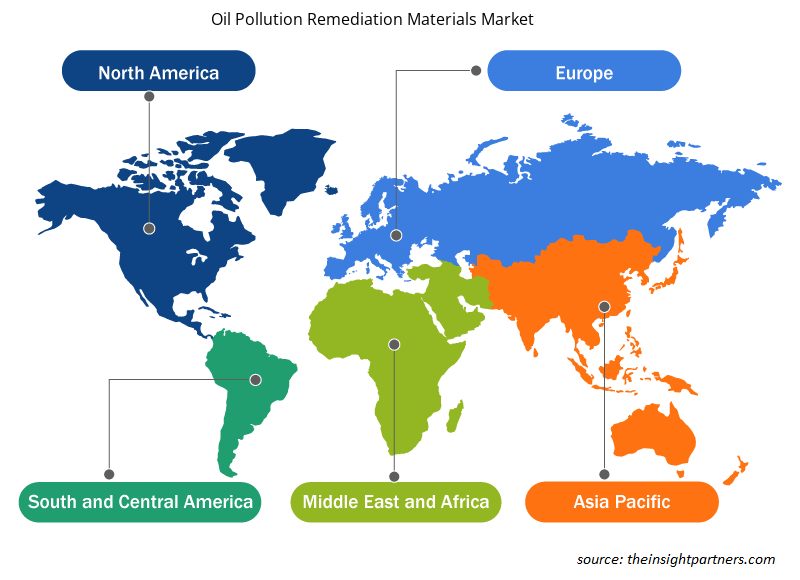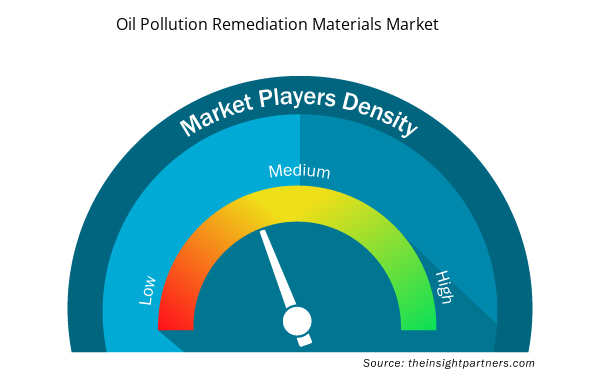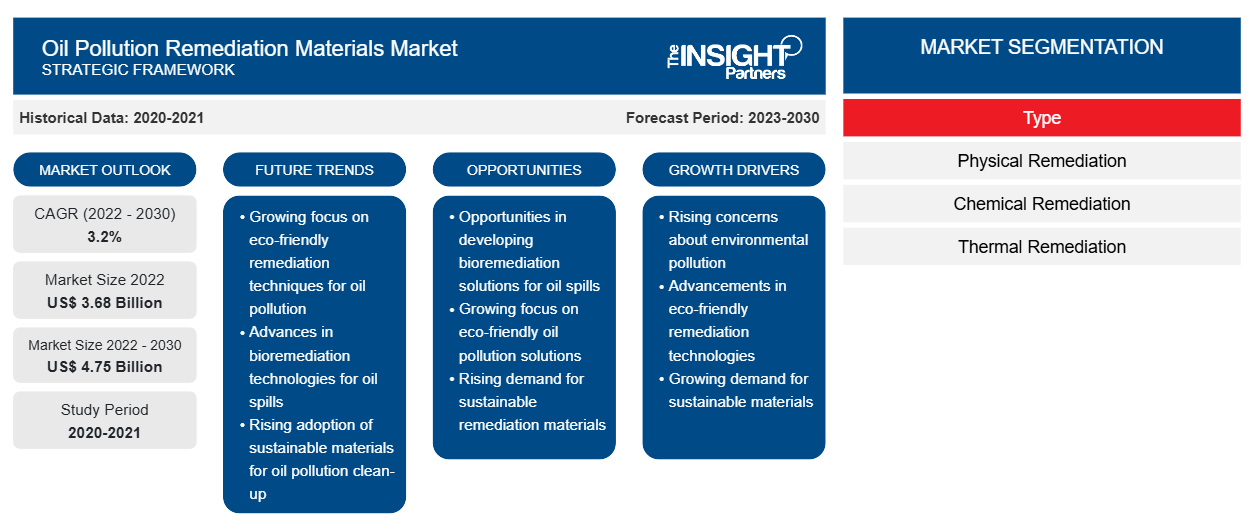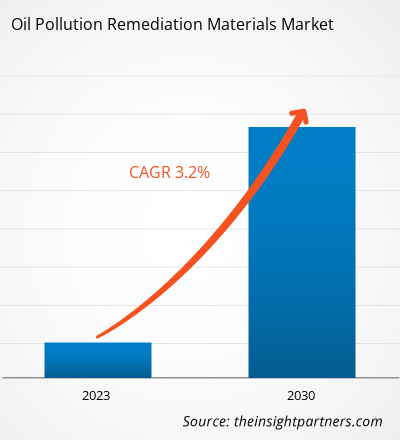[연구 보고서] 석유 오염 정화 재료 시장 분석은 2022년에 3,684.36백만 달러로 평가되었으며 2030년까지 4,749.56백만 달러에 도달할 것으로 예상됩니다. 2022년에서 2030년까지 3.2%의 CAGR을 기록할 것으로 추산됩니다.
시장 분석
오일 오염 정화 재료는 전 세계적으로 진행되는 다양한 석유 탐사, 운송 및 산업 운영 활동으로 인해 수역이 오염될 위험을 줄이는 데 사용됩니다. 정화 기술은 주로 물리적 정화, 화학적 정화, 열적 정화 및 생물학적 정화로 분류됩니다. 이들은 해양 오일 유출 문제를 해결하는 데 매우 중요한 것으로 간주됩니다. 물리적 정화는 붐, 스키머 및 흡착제와 같은 재료로 구성됩니다. 화학적 정화 재료에는 분산제 및 고형제가 포함됩니다.
오일 오염 정화 재료 시장 성장을 주도하는 주요 요인 은 해상 석유 탐사 및 운송 활동의 증가와 오일 유출 대비 및 대응과 관련된 정부 규정입니다. 지난 몇 년 동안 다양한 국가의 정부는 환경 비상 상황에 신속하고 효과적으로 대응할 수 있도록 오일 유출 정화 규정을 설계했습니다. 이러한 규정은 일반적으로 회사가 오일 유출을 봉쇄, 통제 및 정화하기 위해 따라야 하는 절차, 기술 및 표준을 설명합니다. 규정은 종종 환경 영향을 최소화하고 효과적인 정화를 보장하기 위해 사용해야 하는 정화 재료의 유형을 규정합니다. 효과적인 오일 유출 정화에 대한 필요성이 증가함에 따라 정화 재료에 대한 수요가 촉진됩니다.
환경 문제와 규제가 심화됨에 따라, 개선을 위해 고급 친환경 소재를 사용하는 데 대한 강조가 커지고 있습니다. 특정 흡수제, 분산제 및 장벽은 안전 및 효능 기준을 충족하도록 의무화되어, 석유 유출 대응 노력에서 환경 친화적이고 효율적인 소재의 사용을 촉진할 수 있습니다. 정부와 석유 산업은 정기적인 석유 유출 대응을 수행하기 위한 대비 계획을 가지고 있습니다. 정부는 석유 유출을 신속하게 처리하고 생태적 영향을 최소화하도록 명령하여 흡수제, 분산제 및 기타 개선 소재에 대한 수요가 증가했습니다. 2023년에 미국 환경 보호국은 연방 정부의 국가 비상 계획(NCP)에 따라 미국 해역과 인접 해안선에서 석유 유출 대응을 개선하기 위한 표준을 강화했습니다. 이 표준에는 화학 및 생물학적 제제와 같은 효과적인 석유 유출 개선 제품의 개발과 이러한 제품의 사용과 관련된 투명성 및 정보 제공이 포함됩니다.
해상 탐사 및 시추 활동 증가, 파이프라인이나 유조선을 통한 석유 운송, 석유 추출 및 저장 중 인적 오류로 인해 석유 유출 사고 가능성이 높아집니다. 국제 에너지 기구에 따르면, 2021년에 세계 석유 수요가 회복되었고, 아시아는 2025년까지 석유 수요의 77%를 차지할 것으로 예상됩니다. 아시아의 석유 수입 요구량은 2025년까지 하루 3,100만 배럴을 넘어설 것으로 예상됩니다. 아시아 태평양의 여러 국가 정부는 이 지역의 증가하는 석유 수요를 충족하기 위해 석유 프로젝트를 시작했습니다. 2023년에 PETRONAS와 석유 계약자는 19건의 석유 및 가스 탐사 발견과 2건의 탐사 평가 성공을 보고했으며, 이는 말레이시아에 10억 배럴 이상의 석유 상당의 새로운 자원을 제공하는 데 기여했습니다. 이는 지난 몇 년 동안 추진된 강화된 탐사 프로그램의 결과로, 25개의 우물을 시추했습니다. 2015년 이래로 한 해에 시추된 탐사 우물의 수가 가장 많습니다.
성장 동인 및 과제
미국 에너지 정보청이 2024년 1월에 발표한 보고서에 따르면, 2024년 1월 9일 기준 원유 생산량은 COVID-19 팬데믹 이후 증가하여 2년간의 감소 추세가 반전되었습니다. 미국의 원유 생산량은 2021년 1,127만 배럴/일에서 2023년 1,321만 배럴/일로 증가했으며, 2024년까지 1,344만 배럴/일에 도달할 것으로 예상됩니다. 캐나다 에너지 규제 기관에 따르면, 캐나다에서 생산되는 대부분의 원유는 서부 지방에서 파이프라인을 통해 미국, 온타리오, 퀘벡의 정유소로 운송됩니다. Bruegel AISBL이 2023년에 발표한 보고서에 따르면, 러시아는 2021년 전 세계 5대 에너지 생산국이자 소비국에 포함되었습니다. 같은 해에 5억 9,520만 톤의 원유를 생산했고, 그 중 2억 8,660만 톤이 수출되었습니다. 따라서 해상 석유 탐사 및 운송 활동의 증가로 인해 석유 오염 복구 재료 시장이 성장하고 있습니다.
귀하의 요구 사항에 맞게 이 보고서를 사용자 정의하세요
이 보고서의 일부 또는 국가 수준 분석, Excel 데이터 팩을 포함하여 모든 보고서에 대한 사용자 정의를 무료로 받을 수 있으며 신생 기업 및 대학을 위한 훌륭한 혜택과 할인 혜택을 이용할 수 있습니다.
- 이 보고서의 주요 시장 동향을 알아보세요.이 무료 샘플에는 시장 동향부터 추정 및 예측까지 다양한 데이터 분석이 포함됩니다.
보고서 세분화 및 범위
"글로벌 오일 오염 정화 재료 시장 예측 분석"은 다음 세그먼트를 고려하여 수행되었습니다: 유형 및 지역. 이 보고서는 주요 지역 및 국가에서의 수요와 함께 전 세계의 오일 오염 정화 재료 사용에 대한 주요 통계를 제공합니다. 또한 이 보고서는 주요 지역 및 국가에서 시장 성과에 영향을 미치는 요인에 대한 정성적 평가를 제공합니다. 또한 오일 오염 정화 재료 시장의 선도적 기업과 주요 전략적 개발에 대한 포괄적인 분석이 포함되어 있습니다. 시장 역학에 대한 분석도 포함되어 주요 추진 요인, 시장 추세 및 수익성 있는 기회를 식별하는 데 도움이 되며, 이는 차례로 더 높은 수익을 창출하는 데 도움이 됩니다.
생태계 분석과 포터의 5가지 힘 분석은 글로벌 시장에 대한 다각적인 관점을 제공하며, 이를 통해 전체 공급망과 석유 오염 복구 재료 시장 성장에 영향을 미치는 다양한 요소를 이해하는 데 도움이 됩니다.
세그먼트 분석
글로벌 오일 오염 정화 재료 시장은 유형을 기준으로 세분화됩니다. 유형을 기준으로 시장은 물리적 정화(붐, 스키머 및 흡착제 재료), 화학적 정화(분산제 및 응고제), 열적 정화 및 생물학적 정화로 세분화됩니다. 물리적 정화 세그먼트는 가장 큰 오일 오염 정화 재료 시장 점유율을 차지합니다. 물리적 정화는 일반적으로 수중 환경에서 오일 유출을 제어하는 데 사용됩니다. 이는 물 표면에 남아 있는 오일을 특성이 변하지 않고 격리하고 회수하는 데 사용됩니다. 또한 주로 물리적 및 화학적 특성을 변화시키지 않고 오일 유출 확산을 제어하는 장벽으로 사용됩니다. 물리적 정화 방법을 사용하는 가장 일반적인 이점은 오일이 특성을 유지한다는 것입니다. 따라서 미래에도 정제하여 사용할 수 있어 폐기물을 줄이고 잠재적으로 재정적 손실을 완화할 수 있습니다. 물리적 정화 프로세스에는 붐, 스키머 및 흡착제 재료가 포함됩니다.
지역 분석
이 보고서는 북미, 유럽, 아시아 태평양(APAC), 중동 및 아프리카(MEA), 남미 및 중미의 5개 주요 지역과 관련하여 글로벌 오일 오염 정화 재료 시장에 대한 자세한 개요를 제공합니다. 중동 및 아프리카(MEA)는 가장 큰 글로벌 오일 오염 정화 재료 시장 점유율을 차지했으며 2022년에는 1,500백만 달러 이상으로 평가되었습니다. 중동 및 아프리카(MEA)는 이 지역에서 운영되는 주요 석유 시추 사업의 존재를 나타냅니다. 아시아 태평양(APAC) 시장은 2030년까지 1,000백만 달러 이상에 도달할 것으로 예상됩니다. 북미 시장은 2022년부터 2030년까지 약 3%의 CAGR을 기록할 것으로 예상됩니다. 중동 및 아프리카는 주요 원유 매장지의 본거지이며, 지난 몇 년 동안 이 지역에서 원유 탐사 활동의 수가 눈에 띄게 급증했습니다. 석유 탐사 및 생산 작업에 도움이 되는 기술의 발전으로 인해 석유 유출 위험이 증가하여 석유 오염 정화 재료 및 서비스에 대한 수요가 증가했습니다. 따라서 기술 개발은 중동 및 아프리카에서 석유 오염 정화 재료 시장 규모가 커지는 데 기여하고 있습니다.
오일 오염 정화 재료 시장 지역 통찰력
Insight Partners의 분석가들은 예측 기간 동안 오일 오염 정화 재료 시장에 영향을 미치는 지역적 추세와 요인을 철저히 설명했습니다. 이 섹션에서는 북미, 유럽, 아시아 태평양, 중동 및 아프리카, 남미 및 중미의 오일 오염 정화 재료 시장 세그먼트와 지리에 대해서도 설명합니다.

- 오일 오염 정화 재료 시장에 대한 지역별 특정 데이터 얻기
오일 오염 정화 재료 시장 보고서 범위
| 보고서 속성 | 세부 |
|---|---|
| 2022년 시장 규모 | 36억 8천만 달러 |
| 2030년까지 시장 규모 | 47억 5천만 달러 |
| 글로벌 CAGR (2022-2030) | 3.2% |
| 역사적 데이터 | 2020-2021 |
| 예측 기간 | 2023-2030 |
| 다루는 세그먼트 | 유형별로
|
| 포함된 지역 및 국가 | 북아메리카
|
| 시장 선도 기업 및 주요 회사 프로필 |
|
시장 참여자 밀도: 비즈니스 역학에 미치는 영향 이해
오일 오염 정화 재료 시장은 소비자 선호도의 변화, 기술 발전, 제품의 이점에 대한 인식 증가와 같은 요인으로 인해 최종 사용자 수요가 증가함에 따라 빠르게 성장하고 있습니다. 수요가 증가함에 따라 기업은 제품을 확장하고, 소비자의 요구를 충족하기 위해 혁신하고, 새로운 트렌드를 활용하여 시장 성장을 더욱 촉진하고 있습니다.
시장 참여자 밀도는 특정 시장이나 산업 내에서 운영되는 회사나 기업의 분포를 말합니다. 주어진 시장 공간에 얼마나 많은 경쟁자(시장 참여자)가 존재하는지 그 규모나 총 시장 가치에 비해 나타냅니다.
석유 오염 정화 재료 시장에서 운영되는 주요 회사는 다음과 같습니다.
- 사르바 바이오 레메드 LLC
- 오일테크닉스 유한회사
면책 조항 : 위에 나열된 회사는 어떤 특별한 순서에 따라 순위가 매겨지지 않았습니다.

- 석유 오염 정화 재료 시장 주요 주요 업체 개요를 알아보세요
경쟁 환경 및 주요 회사
Sarva Bio Remed LLC, Oil Technics Ltd, Ansell Ltd, Oil-Dri Corp of America, Verde Environmental Group Ltd, Ecolab Inc, Cosco Shipping Heavy Industry Co Ltd, Regenesis, TOLSA SA, CL Solutions LLC는 오일 오염 정화 재료 시장 보고서에 소개된 주요 기업 중 일부입니다. 또한, 시장과 생태계에 대한 전체적인 관점을 얻기 위해 연구 기간 동안 여러 다른 기업이 연구되고 분석되었습니다. 오일 오염 정화 재료 시장 보고서에는 시장에서 경쟁자/기업의 성과를 평가하기 위한 회사 포지셔닝과 집중도도 포함됩니다.
산업 발전 및 미래 기회
석유 오염 복구 재료 시장에서 활동하는 주요 업체가 취한 이니셔티브는 아래와 같습니다.
2022년 11월, Ansell Ltd는 인도의 그린필드 제조 공장에 약 8,000만 달러를 투자했습니다.
- 역사적 분석(2년), 기준 연도, CAGR을 포함한 예측(7년)
- PEST 및 SWOT 분석
- 시장 규모 가치/양 - 글로벌, 지역, 국가
- 산업 및 경쟁 환경
- Excel 데이터 세트


- Virtual Production Market
- 3D Mapping and Modelling Market
- Vision Guided Robotics Software Market
- Small Molecule Drug Discovery Market
- Analog-to-Digital Converter Market
- Smart Water Metering Market
- Medical Enzyme Technology Market
- Asset Integrity Management Market
- 3D Audio Market
- Cosmetic Bioactive Ingredients Market

Report Coverage
Revenue forecast, Company Analysis, Industry landscape, Growth factors, and Trends

Segment Covered
This text is related
to segments covered.

Regional Scope
North America, Europe, Asia Pacific, Middle East & Africa, South & Central America

Country Scope
This text is related
to country scope.
자주 묻는 질문
Based on type, the bioremediation segment is expected to grow fastest during the forecast period. Bioremediation involves the use of additives to accelerate biodegradation, a natural process in which microorganisms break down complex compounds into simpler products to obtain energy and nutrients. Biostimulation and bioaugmentation are two widely used bioremediation approaches.
Increased offshore exploration and drilling activities, transportation of oil via pipelines or tankers, and human errors during oil extraction and storage propel the chances of oil spill incidences. According to the International Energy Agency, the global oil demand rebounded in 2021, and Asia is expected to account for 77% of oil demand by 2025. Asia’s oil import requirements are expected to surpass 31 million barrels per day by 2025. Governments of various countries in Asia Pacific have initiated oil projects to cater to the rising demand for oil in the region.
Based on type, the oil pollution remediation materials market is segmented into physical remediation (booms, skimmers, and adsorbent materials), chemical remediation (dispersants and solidifiers), thermal remediation, and bioremediation. Physical remediation is commonly used to control oil spills in a water environment. It is used to contain and recover oil that remains on the water surface without changing its properties. It is also mainly used as a barrier to control the spreading of oil spills without changing its physical and chemical characteristics.
The major players operating in the global oil pollution remediation materials market are Sarva Bio Remed LLC, Oil Technics Ltd, Ansell Ltd, Oil-Dri Corp of America, Verde Environmental Group Ltd, Ecolab Inc, Cosco Shipping Heavy Industry Co Ltd, Regenesis, TOLSA SA, CL Solutions LLC, Procon Environmental Technologies (Pty) Ltd, Brady Corp, Oil Spill Eater International Corp, Osprey Spill Control, NOV Inc, Fender & Spill Response Services LLC, RX Marine International, Cura Inc, Compania Espanola de Petroleos SA, and SkimOIL LLC.
Rising awareness of environmental issues across the world has led to an emphasis on sustainable practices. Stringent environmental regulations and compliance standards have prompted companies to adopt clean and environment-friendly practices. Companies and governments seek remediation solutions that minimize ecological impact. Thus, market players offering eco-friendly solutions for oil spill cleanup are likely to attract a large customer base and gain favor with regulatory bodies. This demand for eco-friendly solutions aligns with global efforts to mitigate the impact of pollution and support the development of green technologies.
Middle East & Africa accounted for the largest share of the global oil pollution remediation materials market. The Middle East & Africa is home to major crude oil reserves; the number of crude oil exploration activities has surged notably in this region in the past few years. Developments in technologies that aid in oil exploration and production operations have propelled the risk of oil spills, driving the demand for oil pollution remediation materials and services.
Trends and growth analysis reports related to Chemicals and Materials : READ MORE..
The List of Companies - Oil Pollution Remediation Materials Market
- Sarva Bio Remed LLC
- Oil Technics Ltd
- Ansell Ltd
- Oil-Dri Corp of America
- Verde Environmental Group Ltd
- Ecolab Inc
- Cosco Shipping Heavy Industry Co Ltd
- Regenesis
- TOLSA SA
- CL Solutions LLC
The Insight Partners performs research in 4 major stages: Data Collection & Secondary Research, Primary Research, Data Analysis and Data Triangulation & Final Review.
- Data Collection and Secondary Research:
As a market research and consulting firm operating from a decade, we have published and advised several client across the globe. First step for any study will start with an assessment of currently available data and insights from existing reports. Further, historical and current market information is collected from Investor Presentations, Annual Reports, SEC Filings, etc., and other information related to company’s performance and market positioning are gathered from Paid Databases (Factiva, Hoovers, and Reuters) and various other publications available in public domain.
Several associations trade associates, technical forums, institutes, societies and organization are accessed to gain technical as well as market related insights through their publications such as research papers, blogs and press releases related to the studies are referred to get cues about the market. Further, white papers, journals, magazines, and other news articles published in last 3 years are scrutinized and analyzed to understand the current market trends.
- Primary Research:
The primarily interview analysis comprise of data obtained from industry participants interview and answers to survey questions gathered by in-house primary team.
For primary research, interviews are conducted with industry experts/CEOs/Marketing Managers/VPs/Subject Matter Experts from both demand and supply side to get a 360-degree view of the market. The primary team conducts several interviews based on the complexity of the markets to understand the various market trends and dynamics which makes research more credible and precise.
A typical research interview fulfils the following functions:
- Provides first-hand information on the market size, market trends, growth trends, competitive landscape, and outlook
- Validates and strengthens in-house secondary research findings
- Develops the analysis team’s expertise and market understanding
Primary research involves email interactions and telephone interviews for each market, category, segment, and sub-segment across geographies. The participants who typically take part in such a process include, but are not limited to:
- Industry participants: VPs, business development managers, market intelligence managers and national sales managers
- Outside experts: Valuation experts, research analysts and key opinion leaders specializing in the electronics and semiconductor industry.
Below is the breakup of our primary respondents by company, designation, and region:

Once we receive the confirmation from primary research sources or primary respondents, we finalize the base year market estimation and forecast the data as per the macroeconomic and microeconomic factors assessed during data collection.
- Data Analysis:
Once data is validated through both secondary as well as primary respondents, we finalize the market estimations by hypothesis formulation and factor analysis at regional and country level.
- Macro-Economic Factor Analysis:
We analyse macroeconomic indicators such the gross domestic product (GDP), increase in the demand for goods and services across industries, technological advancement, regional economic growth, governmental policies, the influence of COVID-19, PEST analysis, and other aspects. This analysis aids in setting benchmarks for various nations/regions and approximating market splits. Additionally, the general trend of the aforementioned components aid in determining the market's development possibilities.
- Country Level Data:
Various factors that are especially aligned to the country are taken into account to determine the market size for a certain area and country, including the presence of vendors, such as headquarters and offices, the country's GDP, demand patterns, and industry growth. To comprehend the market dynamics for the nation, a number of growth variables, inhibitors, application areas, and current market trends are researched. The aforementioned elements aid in determining the country's overall market's growth potential.
- Company Profile:
The “Table of Contents” is formulated by listing and analyzing more than 25 - 30 companies operating in the market ecosystem across geographies. However, we profile only 10 companies as a standard practice in our syndicate reports. These 10 companies comprise leading, emerging, and regional players. Nonetheless, our analysis is not restricted to the 10 listed companies, we also analyze other companies present in the market to develop a holistic view and understand the prevailing trends. The “Company Profiles” section in the report covers key facts, business description, products & services, financial information, SWOT analysis, and key developments. The financial information presented is extracted from the annual reports and official documents of the publicly listed companies. Upon collecting the information for the sections of respective companies, we verify them via various primary sources and then compile the data in respective company profiles. The company level information helps us in deriving the base number as well as in forecasting the market size.
- Developing Base Number:
Aggregation of sales statistics (2020-2022) and macro-economic factor, and other secondary and primary research insights are utilized to arrive at base number and related market shares for 2022. The data gaps are identified in this step and relevant market data is analyzed, collected from paid primary interviews or databases. On finalizing the base year market size, forecasts are developed on the basis of macro-economic, industry and market growth factors and company level analysis.
- Data Triangulation and Final Review:
The market findings and base year market size calculations are validated from supply as well as demand side. Demand side validations are based on macro-economic factor analysis and benchmarks for respective regions and countries. In case of supply side validations, revenues of major companies are estimated (in case not available) based on industry benchmark, approximate number of employees, product portfolio, and primary interviews revenues are gathered. Further revenue from target product/service segment is assessed to avoid overshooting of market statistics. In case of heavy deviations between supply and demand side values, all thes steps are repeated to achieve synchronization.
We follow an iterative model, wherein we share our research findings with Subject Matter Experts (SME’s) and Key Opinion Leaders (KOLs) until consensus view of the market is not formulated – this model negates any drastic deviation in the opinions of experts. Only validated and universally acceptable research findings are quoted in our reports.
We have important check points that we use to validate our research findings – which we call – data triangulation, where we validate the information, we generate from secondary sources with primary interviews and then we re-validate with our internal data bases and Subject matter experts. This comprehensive model enables us to deliver high quality, reliable data in shortest possible time.


 이 보고서에 대한 무료 샘플을 받으세요
이 보고서에 대한 무료 샘플을 받으세요